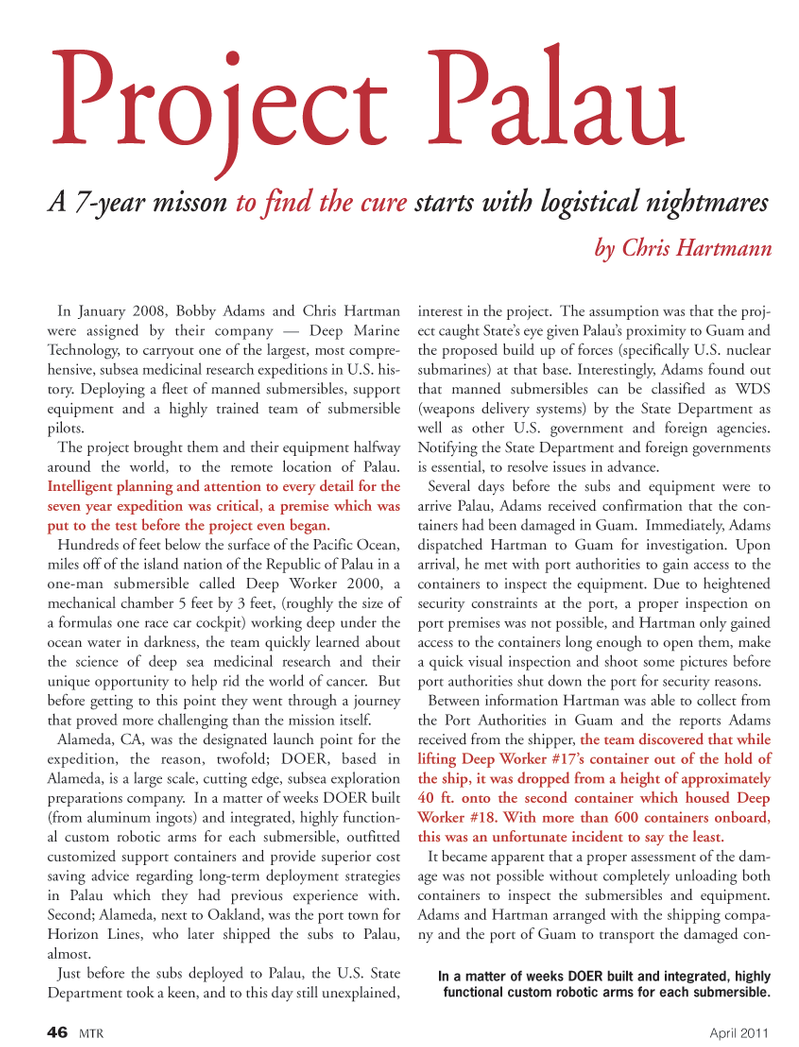
Page 46: of Marine Technology Magazine (April 2011)
Oil & Gas SubSea Monitoring
Read this page in Pdf, Flash or Html5 edition of April 2011 Marine Technology Magazine
In January 2008, Bobby Adams and Chris Hartman were assigned by their company — Deep Marine
Technology, to carryout one of the largest, most compre- hensive, subsea medicinal research expeditions in U.S. his- tory. Deploying a fleet of manned submersibles, support equipment and a highly trained team of submersible pilots.
The project brought them and their equipment halfway around the world, to the remote location of Palau.
Intelligent planning and attention to every detail for the seven year expedition was critical, a premise which was put to the test before the project even began.
Hundreds of feet below the surface of the Pacific Ocean, miles off of the island nation of the Republic of Palau in a one-man submersible called Deep Worker 2000, a mechanical chamber 5 feet by 3 feet, (roughly the size of a formulas one race car cockpit) working deep under the ocean water in darkness, the team quickly learned about the science of deep sea medicinal research and their unique opportunity to help rid the world of cancer. But before getting to this point they went through a journey that proved more challenging than the mission itself.
Alameda, CA, was the designated launch point for the expedition, the reason, twofold; DOER, based in
Alameda, is a large scale, cutting edge, subsea exploration preparations company. In a matter of weeks DOER built (from aluminum ingots) and integrated, highly function- al custom robotic arms for each submersible, outfitted customized support containers and provide superior cost saving advice regarding long-term deployment strategies in Palau which they had previous experience with.
Second; Alameda, next to Oakland, was the port town for
Horizon Lines, who later shipped the subs to Palau, almost.
Just before the subs deployed to Palau, the U.S. State
Department took a keen, and to this day still unexplained, interest in the project. The assumption was that the proj- ect caught State’s eye given Palau’s proximity to Guam and the proposed build up of forces (specifically U.S. nuclear submarines) at that base. Interestingly, Adams found out that manned submersibles can be classified as WDS (weapons delivery systems) by the State Department as well as other U.S. government and foreign agencies.
Notifying the State Department and foreign governments is essential, to resolve issues in advance.
Several days before the subs and equipment were to arrive Palau, Adams received confirmation that the con- tainers had been damaged in Guam. Immediately, Adams dispatched Hartman to Guam for investigation. Upon arrival, he met with port authorities to gain access to the containers to inspect the equipment. Due to heightened security constraints at the port, a proper inspection on port premises was not possible, and Hartman only gained access to the containers long enough to open them, make a quick visual inspection and shoot some pictures before port authorities shut down the port for security reasons.
Between information Hartman was able to collect from the Port Authorities in Guam and the reports Adams received from the shipper, the team discovered that while lifting Deep Worker #17’s container out of the hold of the ship, it was dropped from a height of approximately 40 ft. onto the second container which housed Deep
Worker #18. With more than 600 containers onboard, this was an unfortunate incident to say the least.
It became apparent that a proper assessment of the dam- age was not possible without completely unloading both containers to inspect the submersibles and equipment.
Adams and Hartman arranged with the shipping compa- ny and the port of Guam to transport the damaged con-
Project Palau
A 7-year misson to find the cure starts with logistical nightmares by Chris Hartmann
In a matter of weeks DOER built and integrated, highly functional custom robotic arms for each submersible. 46 MTR April 2011

 45
45

 47
47
